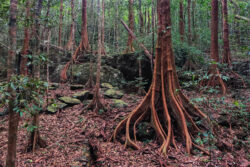Millipedes form a uniquely diverse assemblage of arthropods that have crawled their way to almost every part of the world, except the poles. They range across almost all terrestrial habitats including deserts and high altitudes, and a few groups are semi-aquatic as well. Millipedes majorly exist in leaf litter and upper soil, but many species are habitat specialists, and their habitat preferences have possibly impacted their body form and morphological characters. The ones restricted to mineral soil have miniaturised or elongated bodies (more streamlined), shorter appendages, duller outer-body and reduced eye vision. On the other hand, the ones that prefer under-bark habitats are found to be flat-bodied, or thin bodied, or are miniaturised. A few millipedes are cave-dwelling and they have elongated legs and antennae (often referred to as cave gigantism), reduced vision and mouthpart modifications.
Millipedes are mostly detritivorous – i.e. they feed on decaying plant matter (leaf litter, bark, etc). However, many millipede taxa feed on seeds, fallen fruits, mushrooms, faeces and even dead invertebrates. When it comes to their feeding behaviour, they are opportunistic generalists but their specific food preferences have been shown to be influenced by their habitat. These macroarthropods provide paramount ecosystem services by feeding on and “transforming” substantial leaf litter around the world – they defecate pellets of the fragmented leaf litter, which eases microbial decomposition of plant matter. This contributes to the transformation of organic carbon and nitrogen from leaf litter to mineralised forms (carbonates, nitrates and ammonium), which then makes the soil more nutrient-rich.

A flat-backed millipede feeding on decaying plant matter.

A pill millipede feeding on decaying plant matter.
Millipedes, like centipedes, have a segmented body with multiple appendages. However, unlike how centipedes have one pair of appendages emerging from each segment, every millipede segment gives rise to two pairs of appendages. Owing to this feature, the class comprising millipedes is known as ‘Diplopoda’ and it comprises 16 extant orders. The classification of these orders have been based on morphological characters and behaviour, and the major types based on their function and behaviour are rammers, wedge-type millipedes, borers, bark dwellers and rollers.
Rammers are represented by the orders Julida, Spirostreptida, Spirobolida and Callipodida, and are characterised by a rigid-capped head, bent underneath, used to ram against substrates, which aids them in burrowing.

A rammer millipede, belonging to the Juliformian order.

Another rammer millipede, also belonging to the Juliformian order.
The wedge-type body form, represented by Polydesmida, is constituted by rigid, wing-like paranota (dorsolateral projections in each segment) which facilitate movement through crevices, particularly in leaf litter.

A wedge-type millipede, belonging to order Polydesmida.

Another wedge-type millipede (order Polydesmida).
Borers are characterised by strongly tapered front ends, shorter legs than the wedge-types, and some show keel-like paranota. These are predominantly exhibited by Colobognathans (comprising orders – Polyzoniida, Platydesmida and Siphonophorida) and some Chordeumatida.
Rollers roll into spheres when they sense harm or are disturbed, and have evolved convergently in multiple millipede groups. They are represented by pill millipedes (Sphaerotheriida and Glomerida), Polydesmidans, few Juliformians and few Polyzoniidans.

A roller type millipede – a juliformian

Another roller millipede – a pill millipede
Lastly, bark dwellers are represented by minute, soft-bodied, bristly millipedes from order Polyxenida, which are capable of withstanding much drier conditions than other millipedes.
Diversity in these invertebrates is not just confined to the morphological axis. Many diplopods are poisonous and they possess the ability to produce defensive chemicals – these are phenol-based, hydroquinone-based or benzoquinone-based, and there is high variation in the composition of these secretions across taxonomic groups. Millipedes diverged from their venomous sister group, centipedes (class Chilopoda) before 450 Mya, but as per findings from a recent study, chemical defenses in millipedes originated only around 300 Mya. Also, interestingly patterns of colouration have been seen in millipede orders (Spirobolida, Spirostreptida, Polydesmida, Platydesmida, Siphonocryptida, and Chordeumatida) that originated post 300 Mya. Scientists have hypothesised that these elaborate colouration patterns evolved to act as warning signals of poison to potential predators. However, the evolutionary association between poison and colour has, so far, not been studied explicitly.

A pill millipede taking a stroll in the forest.

A Spirobolidan millipede on a forest floor.
India, more importantly peninsular India, is a unique abode for diverse assemblages of biota, and it harbours one of the major biodiversity hotspots – the Western Ghats. Peninsular India houses around 11 amongst 16 orders of millipedes, and at least 7 of these orders are found in the Western Ghats. Different groups of them have restricted distribution ranges and are found nowhere else in peninsular India or the world. Therefore, it makes one question what their survival strategies were in the past, and what drove their diversity and distribution patterns. Summing it up, millipedes thus provide excellent scope as a model to understand their ecology, and how evolution shaped diversity not just in terms of species numbers, but also in terms of morphology, poison, and colour, to name a few.





Instagram
junglelodgesjlr